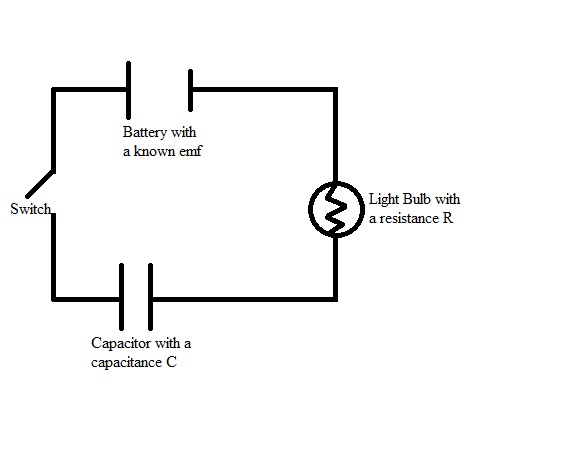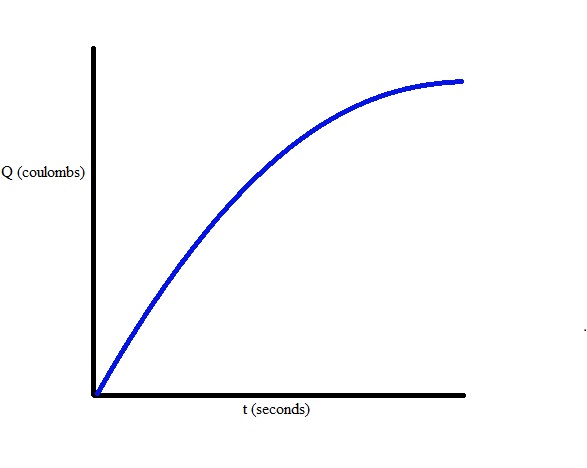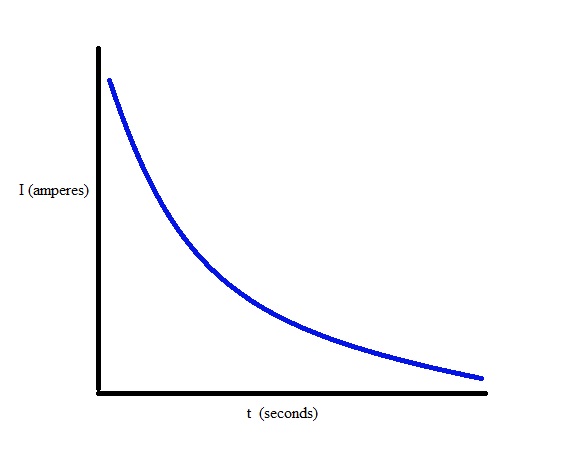Charge in a RC Circuit
By Isabella Hoskins
This page gives a quantitative analysis of how to obtain the charge of a capacitor in a series RC Circuit with time.
The Main Idea
Above is a RC circuit in series, which contains an ideal battery with a emf, a light bulb (which has a resistance R), an uncharged capacitor with a capacitance C, and a switch. When the switch is closed, electrons flow from the negative end of the battery to the capacitor, where they accumulate on one of the plates of the capacitor, thus causing the plate to acquire a negative charge. This charge causes an electrostatic field that pushes the electrons on the second plate away from the second plate, which not only results a positive charge on the second plate, but also allows the current to move throughout the rest of the circuit. As a result, the initial brightness of the bulb would be the same brightness of the bulb in a circuit without a capacitor.
However, as capacitor becomes charge (i.e. more electrons pile up on the negative plate), an opposing electric field from the negative plate of the capacitor slows the current and the bulb begins to dim. Once the capacitor is fully charge, current stops flowing in the circuit and the bulb no longer shines.
Our goal is to obtain an equation that shows how the charge of the capacitor changes with time.
A Mathematical Model
Below are some important equations that will help achieve this equation:
[math]\displaystyle{ {V}_{round trip} = 0 }[/math]
[math]\displaystyle{ {V} = IR }[/math], where I is the current of the circuit and R is the resistance of the resistor.
[math]\displaystyle{ {Q} = CV }[/math], where Q is the charge of the capacitor, C is the capacitance of the capacitor, and V is the change in potential difference across the capacitor.
In a circuit loop, the change of potential difference has to be zero. The equation below describes the change of potential difference of the circuit above:
[math]\displaystyle{ {V}_{round trip} = emf-RI-Q/C = 0 }[/math]
Initially, the capacitor is not charge ([math]\displaystyle{ {Q} = 0 }[/math]), so the loop equation becomes:
[math]\displaystyle{ {V}_{round trip} = emf-RI = 0 }[/math] (for initial state)
[math]\displaystyle{ {I}_{0} = {\frac{emf}{R}} }[/math]. This current [math]\displaystyle{ {I}_{0} }[/math] resembles a current in a circuit that has no capacitor.
When the capacitor becomes fully charged, the current stops in the circuit. Thus, the RI becomes zero and the loop equation is now the following:
[math]\displaystyle{ {V}_{round trip} = emf-Q/C = 0 }[/math] (for final state)
[math]\displaystyle{ {Q} = emf*C }[/math]
This shows that the resistor depends on the emf of the battery and the capacitance. The resistor, then, determines the amount of time it takes to reach the circuit's final state.
Knowing this, it is possible to assume that the rate of charge Q of the plate is equal to [math]\displaystyle{ {I} = dQ/dt }[/math]. By taking the derivative of all the terms in the closed loop equation, the following equation is achieved:
[math]\displaystyle{ {V}_{round trip} = emf-RI-Q/C = 0 }[/math]
[math]\displaystyle{ {\frac{d(emf)}{dt}-R\frac{I}{dt}-\frac{dQ}{dt}/C = 0} }[/math]
[math]\displaystyle{ {R\frac{dI}{dt} = -I/C } }[/math] , since [math]\displaystyle{ {\frac{d(emf)}{dt}} }[/math] goes to zero since emf does not change with time and [math]\displaystyle{ {I}= \frac{dQ}{dt} }[/math]
[math]\displaystyle{ {R\frac{dI}{dt}(1/I) = -1/C } }[/math]
By integrating the right side of the equation from [math]\displaystyle{ {I}_{0} }[/math] to [math]\displaystyle{ {I} }[/math] and the right side of the equation from time 0 to t (the amount of time to get the capacitor fully charged), we get the following equation:
[math]\displaystyle{ R\int_{{I}_{0}}^I \frac{dI}{I}\,\mathrm{d}t=-(1/C) \int_0^t\,\mathrm{d}t }[/math]
[math]\displaystyle{ {lnI-ln{I}_{0} = {\frac{-1}{RC}}dt} }[/math]
[math]\displaystyle{ {ln(IR/V) = {\frac{-1}{RC}}dt} }[/math], since [math]\displaystyle{ {I}_{0} = {\frac{V}{R}} }[/math]
[math]\displaystyle{ {I} = {\frac{dQ}{dt}}={\frac{emf-Q/C}{R}} }[/math]
If both sides are exponentiate, the following is achieved
[math]\displaystyle{ {\frac{IR}{emf}} = {e^{\frac{-t}{RC}}} }[/math]
[math]\displaystyle{ {I} = {\frac{emf}{R}e^{\frac{-t}{RC}}={\frac{dQ}{dt}}} }[/math]
[math]\displaystyle{ {dQ} = \int_0^t{\frac{emf}{R}e^{\frac{-t}{RC}}\,\mathrm{d}t} }[/math]
[math]\displaystyle{ {Q} = {C(emf)(1-e^{\frac{-t}{RC}})} }[/math]. This is the charge in a series RC Circuit with respect to time.
A Computational Model
The charge equation achieved above can also be achieved by thinking analytically. At [math]\displaystyle{ {t} = {0} }[/math], the capacitor acquires a new charge [math]\displaystyle{ {dQ}_{1} }[/math], which can be calculated as [math]\displaystyle{ {dQ}_{1}= {Q}_{0} + dQ = (emf/R)dt }[/math], since [math]\displaystyle{ {Q}_{0} = {0} }[/math]. After another small increment has passed, the capacitor gains a new charge [math]\displaystyle{ {dQ}_{2} }[/math], which is calculate as [math]\displaystyle{ {dQ}_{2} = {{Q}_{1} + \frac{dQ}{dt}}={{Q}_{1}+\frac{emf-{Q}_{1}/C}{R}} }[/math]. Notice that [math]\displaystyle{ {\frac{dQ}{dt}} }[/math] is smaller than the first time increment. In fact, if the charge of the capacitor is graphed, it looks like an exponential function.
Additionally, since it is known as Q increases, I should decrease due to the growing fridge field of a capacitor. As a result, its graph should look something like this:
By looking at the graph, one could make an educated guess that I should be given to a similar equation to [math]\displaystyle{ {I} = {{I}_{0}e^{-at}} }[/math]. The following is done to find the value of a:
[math]\displaystyle{ {I} = {\frac{dQ}{dt}}={\frac{emf-Q/C}{R}} }[/math]
[math]\displaystyle{ \frac{dI}{dt} = \frac{-1}{RC}\frac{dQ}{dt} = \frac{-1}{RC}I }[/math]
Because [math]\displaystyle{ \frac{d({I}_{0}e^{-at})}{dt} = {-aI} }[/math], [math]\displaystyle{ {a} = \frac{1}{RC} }[/math], thus resulting in the equation [math]\displaystyle{ {I} = {I}_{0}e^{\frac{-t}{RC}} }[/math], which is the same equation that was derived in the mathematical model section.
Examples
Below are some examples concerning the charge in an RC Circuit. These examples are drawn from page 802 of Matters & Interactions: electric & Magnetic Interactions by Ruth W. Chabay and Bruce A. Sherwood.
Simple
A resistor with a resistance of 20 ohms and a capacitor with a capacitance of 2 Farads are in series with a 9 Volt battery. What is the charge of the capacitor after 50 seconds?
Solution: To solve this equation, just plug the data into the equation [math]\displaystyle{ {Q} = {C(emf)(1-e^{\frac{-t}{RC}})} }[/math].
[math]\displaystyle{ {Q} = {2F(9V)(1-e^{\frac{-50}{20 ohms*2F}})} }[/math]
[math]\displaystyle{ {Q} = {12.84 C} }[/math]
Middling
A) A resistor with a resistance R and an air-gap capacitor of capacitance C are connected in series to a battery with a potential difference of emf. What is the final charge on the capacitor? B) After fully charging the capacitor (so there is no current), a sheet of plastic whose dielectric constant is K is inserted into the capacitor and fills the gap. What happens next?
Solution:
A) When the capacitor becomes fully charged, the current stops in the circuit . Thus, the RI becomes zero and the loop equation is now the following:[math]\displaystyle{ {V}_{round trip} = emf-Q/C = 0 }[/math] (for final state). Therefore, [math]\displaystyle{ {Q} = emf*C }[/math]
B)The molecules in the plastic polarize, which creases a new electric field that reduces the fringe field caused by the plates. A new current starts running in the circuit until the fridge field grows large enough to cancel the electric field that drives the current.
Difficult
A)In the example of middle difficulty, what is the initial current through the resistor just after inserting the sheet of plastic? B)What is the final charge on the capacitor after the circuit reaches the new equilibrium?
Solution:
A)[math]\displaystyle{ {V}_{ins} = {\frac{emf}{K}} }[/math]
[math]\displaystyle{ {I}={\frac{V}{R}} }[/math]
[math]\displaystyle{ {I} = {I}_{0}-{I}_{vac} }[/math]
[math]\displaystyle{ {I} = {\frac{emf}{R}}-{\frac{emf}{KR}} }[/math]
[math]\displaystyle{ {I} = {\frac{emf}{R}}{(1-1/K)} }[/math].
B) [math]\displaystyle{ {Q}={C}{V}_{ins} }[/math]
[math]\displaystyle{ {V}={CK(emf)} }[/math]
Connectedness
RC Circuits are used in various equipment, such as potentiometers, digital-to-analog conversion (which is used in a computer), two speaker system, and accelerometers. Many electrical engineers will encounter RC Circuit in their advanced classes.
History
Georg Ohm (1798 to 1854) was a German mathematician who began to research with a electrochemical cell and electric circuits during his career as a teacher at Cologne. After various expirements, he wrote his book The Galvanic Circuit Investigated Mathematically (1827), in which the now called Ohm's law first appeared. In his works he stated that the potential difference of a circuit is proportional to the current and the resistance of the circuit ([math]\displaystyle{ V=IR }[/math]). Initially, it was not well received, and the poor feedback was so great that he resigned from his job at Cologne. However, in 1841 he was proven right and was made a foreign member of the Royal Society of London. In order of his work, the unit for measuring resistance, ohms, was named after him.
See also
Here are similar topics that are related to circuits:
Components of a Circuit: http://www.physicsbook.gatech.edu/Components
Charging and Discharging a Capacitor: http://www.physicsbook.gatech.edu/Charging_and_Discharging_a_Capacitor
RC Circuits: http://www.physicsbook.gatech.edu/RC
How to derive the current in an RC Circuit: http://www.physicsbook.gatech.edu/Current_in_a_RC_circuit
Further Readings
Chabay, Ruth W., and Bruce A. Sherwood. Matter and Interactions. Hoboken, NJ: Wiley, 2011. Print.
External links
http://www.phys.columbia.edu/~cole/c1493/dcCircuits.pdf https://www.khanacademy.org/science/physics/circuits-topic
References
http://www.phys.columbia.edu/~cole/c1493/dcCircuits.pdf http://www.britannica.com/biography/Georg-Simon-Ohm http://www.dummies.com/how-to/content/top-ten-practical-applications-of-circuit-analysis.html


